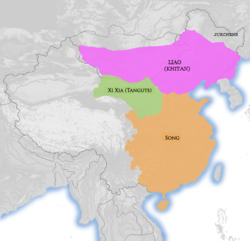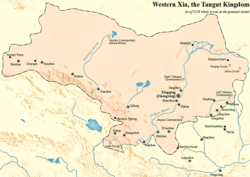เซี่ยตะวันตก
ต้าเซี่ย | |||||||||||||||||||
|---|---|---|---|---|---|---|---|---|---|---|---|---|---|---|---|---|---|---|---|
| ค.ศ. 1038–ค.ศ. 1227 | |||||||||||||||||||
 ที่ตั้งของเซี่ยตะวันตกใน ค.ศ. 1111 (สีเขียวทางตะวันตกเฉียงเหนือ) | |||||||||||||||||||
 เซี่ยตะวันตกใน ค.ศ. 1150 | |||||||||||||||||||
| สถานะ | จักรวรรดิ | ||||||||||||||||||
| เมืองหลวง | ซิงชิ่ง (ปัจจุบันคืออิ๋นชวัน) | ||||||||||||||||||
| ภาษาทั่วไป | ตังกุต, จีน | ||||||||||||||||||
| ศาสนา | หลัก: พุทธ รอง: ลัทธิเต๋า ลัทธิขงจื๊อ ศาสนาชาวบ้านจีน | ||||||||||||||||||
| การปกครอง | ราชาธิปไตย | ||||||||||||||||||
| จักรพรรดิ | |||||||||||||||||||
• 1038–1048 | จิงจง | ||||||||||||||||||
• 1206–1211 | เสียงจง | ||||||||||||||||||
• 1226–1227 | โม่จู | ||||||||||||||||||
| ยุคประวัติศาสตร์ | สมัยหลังคลาสสิก | ||||||||||||||||||
• หลี่ จี้เชียนก่อการกบฏต่อราชวงศ์ซ่ง | ค.ศ. 984 | ||||||||||||||||||
• ก่อตั้งราชวงศ์โดยจักรพรรดิจิงจง | ค.ศ. 1038 | ||||||||||||||||||
• ถูกจักรวรรดิมองโกลปราบปราม | ค.ศ. 1210 | ||||||||||||||||||
• ราชวงศ์ถูกทำลายหลังก่อกบฏ | ค.ศ. 1227 | ||||||||||||||||||
| พื้นที่ | |||||||||||||||||||
| ประมาณ ค.ศ. 1100[1] | 1,000,000 ตารางกิโลเมตร (390,000 ตารางไมล์) | ||||||||||||||||||
| ประชากร | |||||||||||||||||||
• สูงสุด | 3,000,000 คน[2][3][4] | ||||||||||||||||||
| สกุลเงิน | การแลกเปลี่ยนสินค้าด้วยเหรียญทองแดงในเมือง[5] | ||||||||||||||||||
| |||||||||||||||||||
| ปัจจุบันเป็นส่วนหนึ่งของ | จีน มองโกเลีย | ||||||||||||||||||
| เป็นส่วนหนึ่งของ |
| ประวัติศาสตร์จีน |
|---|
เซี่ยตะวันตก หรือ ซีเซี่ย (จีน: 西夏; พินอิน: Xī Xià; เวด-ไจลส์: Hsi1 Hsia4) มีชื่อทางการว่า ต้าเซี่ย (จีน: 大夏; พินอิน: Dà Xià) ซึ่งมีอีกชื่อว่า จักรวรรดิตังกุต และในภาษาตังกุตและทิเบตว่า Mi-nyak[6] เป็นชื่ออาณาจักรแห่งหนึ่งซึ่งดำรงอยู่ตั้งแต่ ค.ศ. 1038 ถึง 1227 ณ บริเวณที่ปัจจุบันเป็นเขตกานซู ชิงไห่ ซินเจียง มองโกเลียนอก มองโกเลียใน ส่านซี และหนิงเซี่ย ของสาธารณรัฐประชาชนจีน กินพื้นที่ราว 800,000 ตารางกิโลเมตร (310,000 ตารางไมล์)[7][8][9]
อาณาจักรเซี่ยตะวันตกถูกพวกมองโกลจากจักรวรรดิมองโกลทำลายโดยสิ้นเชิง เป็นเหตุให้บันทึกและสถาปัตยกรรมล้วนดับสูญ ฉะนั้น ประวัติศาสตร์ของอาณาจักรนี้จึงเป็นที่โต้เถียงเรื่อยมา จนกระทั่งมีการสำรวจขนานใหญ่จากฝรั่งและคนจีนเอง จึงพบว่า อาณาจักรเซี่ยตะวันตกประสบความสำเร็จอย่างใหญ่หลวงในด้านนาฏกรรม วรรณกรรม ศิลปกรรม และสถาปัตยกรรม ชนิดที่นักประวัติศาสตร์ถือกันว่า เป็นผลงานที่ "รุ่งโรจน์เรืองรอง" (shining and sparkling)[10] อนึ่ง ยังพบว่า อาณาจักรเซี่ยตะวันตกสามารถจัดระเบียบกองทัพอย่างเป็นระบบ กองทัพเซี่ยมีทั้งพลธนู พลปืน (ติดตั้งปืนใหญ่ไว้บนหลังอูฐ) พลม้า พลรถ พลโล่ และทแกล้ว (ทหารที่เก่งทั้งน้ำและบก) อาณาจักรเซี่ยตะวันตกจึงรุกรานอาณาจักรรอบข้าง เช่น จิน ซ่ง และเหลียวได้อย่างมีประสิทธิภาพ[11]
อ้างอิง
[แก้]- ↑ Turchin, Peter; Adams, Jonathan M.; Hall, Thomas D. (ธันวาคม 2006). "East-West Orientation of Historical Empires". Journal of World-Systems Research. 12 (2): 222. ISSN 1076-156X. สืบค้นเมื่อ 16 กันยายน 2016.
- ↑ Kuhn, Dieter (15 ตุลาคม 2011). The Age of Confucian Rule: The Song Transformation of China (Reprint ed.). Belknap Press: An Imprint of Harvard University Press. p. 50. ISBN 978-0-674-06202-3.
- ↑ Bowman, Rocco (2014). "Bounded Empires: Ecological and Geographic Implications in Sino- Tangut Relations, 960-1127" (PDF). The Undergraduate Historical Journal at UC Merced. 2: 11. doi:10.5070/H321025689.
- ↑ McGrath, Michael C. Frustrated Empires: The Song-Tangut Xia War of 1038-44. In Wyatt. p. 153.
- ↑ Chinaknowledge.de Chinese History - Western Xia Empire Economy. 2000 ff. © Ulrich Theobald. สืบค้นเมื่อ 13 กรกฎาคม 2017.
- ↑ Stein (1972), pp. 70–71.
- ↑ Wang, Tianshun [王天顺] (1993). Xixia Zhan Shi [The Battle History of Western Xia] 《西夏战史》. Yinchuan [银川], Ningxia ren min chu ban she [Ningxia People's Press] 宁夏人民出版社.
- ↑ Bian, Ren [边人] (2005). Xixia: xiaoshi zai lishi jiyi zhong de guodu [Western Xia: the kingdom lost in historical memories] 《西夏: 消逝在历史记忆中的国度》. Beijing [北京], Waiwen Chubanshe [Foreign Languages Press] 外文出版社.
- ↑ Li, Fanwen [李范文] (2005). Xixia tong shi [Comprehensive History of Western Xia] 西夏通史. Beijing [北京] and Yinchuan [银川], Ren min chu ban she [People's Press] 人民出版社; Ningxia ren min chu ban she [Ningxia People's Press] 宁夏人民出版社.
- ↑ Zhao, Yanlong [赵彦龙] (2005). "Qian tan xi xia gong wen wen feng yu gong wen zai ti [A brief discussion on the writing style in official documents and documental carrier] 浅谈西夏公文文风与公文载体." Xibei min zu yan jiu [Northwest Nationalities Research] 西北民族研究 45 (2): 78–84.
- ↑ Qin, Wenzhong [秦文忠], Zhou Haitao [周海涛] and Qin Ling [秦岭] (1998). "Xixia jun shi ti yu yu ke xue ji shu [The military sports, science and technology of West Xia] 西夏军事体育与科学技术." Ningxia Daxue Xuebao [Journal of Ningxia University] 《宁夏大学学报》79 (2): 48–50.
ข้อมูล
[แก้]- Andrade, Tonio (2016), The Gunpowder Age: China, Military Innovation, and the Rise of the West in World History, Princeton University Press, ISBN 978-0-691-13597-7.
- Asimov, M. S. (1998), History of civilizations of Central Asia Volume IV The age of achievement: A.D. 750 to the end of the fifteenth century Part One The historical, social and economic setting, UNESCO Publishing
- Barfield, Thomas (1989), The Perilous Frontier: Nomadic Empires and China, Basil Blackwell
- Barrett, Timothy Hugh (2008), The Woman Who Discovered Printing, Great Britain: Yale University Press, ISBN 978-0-300-12728-7 (alk. paper)
- Beckwith, Christopher I (1987), The Tibetan Empire in Central Asia: A History of the Struggle for Great Power among Tibetans, Turks, Arabs, and Chinese during the Early Middle Ages, Princeton University Press
- Bregel, Yuri (2003), An Historical Atlas of Central Asia, Brill
- Dorje, Gyurme (1999), Footprint Tibet Handbook with Bhutan, Footprint Handbooks
- Drompp, Michael Robert (2005), Tang China And The Collapse Of The Uighur Empire: A Documentary History, Brill
- Ebrey, Patricia Buckley (1999), The Cambridge Illustrated History of China, Cambridge, England: Cambridge University Press, ISBN 0-521-66991-X (paperback).
- Ebrey, Patricia Buckley; Walthall, Anne; Palais, James B. (2006), East Asia: A Cultural, Social, and Political History, Boston, MA: Houghton Mifflin, ISBN 0-618-13384-4
- Ferenczy, Mary (1984), The Formation of Tangut Statehood as Seen by Chinese Historiographers, Akadémiai Kiadó, Budapest
- Forage, Paul C. (1991), "The Sino-Tangut War of 1081-1085", Journal of Asian History, 25 (1): 1–28, JSTOR 41930788
- Golden, Peter B. (1992), An Introduction to the History of the Turkic Peoples: Ethnogenesis and State-Formation in Medieval and Early Modern Eurasia and the Middle East, OTTO HARRASSOWITZ · WIESBADEN
- Graff, David A. (2002), Medieval Chinese Warfare, 300-900, Warfare and History, London: Routledge, ISBN 0-415-23955-9
- Graff, David Andrew (2016), The Eurasian Way of War Military Practice in Seventh-Century China and Byzantium, Routledge, ISBN 978-0-415-46034-7.
- Guy, R. Kent (2010), Qing Governors and Their Provinces: The Evolution of Territorial Administration in China, 1644-1796, Seattle, WA: University of Washington Press, ISBN 9780295990187
- de Hartog, Leo (2004), Genghis Khan: Conqueror of the World, New York, NY: I.B. Tauris, ISBN 1860649726
- Haywood, John (1998), Historical Atlas of the Medieval World, AD 600-1492, Barnes & Noble
- Kepping, Ksenia Borisovna (1994), The Name of the Tangut Empire
- Kwanten, Luc (1974), Chingis Kan's Conquest of Tibet, Myth or Reality, Journal of Asian History
- Latourette, Kenneth Scott (1964), The Chinese, their history and culture, Volumes 1–2, Macmillan
- Leffman, David (2005), The Rough Guide to China, Rough Guides
- Lorge, Peter A. (2008), The Asian Military Revolution: from Gunpowder to the Bomb, Cambridge University Press, ISBN 978-0-521-60954-8
- Lorge, Peter (2015), The Reunification of China: Peace through War under the Song Dynasty, Cambridge University Press
- Mackintosh-Smith, Tim (2014), Two Arabic Travel Books, Library of Arabic Literature
- Man, John (2004), Genghis Khan: Life, Death, and Resurrection, New York, NY: St. Martin's Press, ISBN 9780312366247
- McGrath, Michael C. (2008), Frustrated Empires: The Song-Tangut Xia War of 1038-1044
- Millward, James (2009), Eurasian Crossroads: A History of Xinjiang, Columbia University Press
- Mote, F. W. (2003), Imperial China: 900–1800, Harvard University Press, ISBN 978-0674012127
- Needham, Joseph (1986), Science & Civilisation in China, vol. 7, Cambridge University Press, ISBN 0-521-30358-3
- Perry, John C.; L. Smith, Bardwell (1976), Essays on T'ang Society: The Interplay of Social, Political and Economic Forces, Leiden, The Netherlands: E. J. Brill, ISBN 90-04-047611
- Rong, Xinjiang (2013), Eighteen Lectures on Dunhuang, Brill
- Shaban, M. A. (1979), The ʿAbbāsid Revolution, Cambridge, England: Cambridge University Press, ISBN 0-521-29534-3
- Sima, Guang (2015), Bóyángbǎn Zīzhìtōngjiàn 54 huánghòu shīzōng 柏楊版資治通鑑54皇后失蹤, Yuǎnliú chūbǎnshìyè gǔfèn yǒuxiàn gōngsī, ISBN 978-957-32-0876-1
- Skaff, Jonathan Karam (2012), Sui-Tang China and Its Turko-Mongol Neighbors: Culture, Power, and Connections, 580-800 (Oxford Studies in Early Empires), Oxford University Press
- Smith, Paul Jakov (2015), A Crisis in the Literati State
- Stein, R. A. (1972), Tibetan Civilization, London and Stanford University Press
- Twitchett, D. (1979), Cambridge History of China, Sui and T'ang China 589-906, Part I, vol. 3, Cambridge University Press, ISBN 0-521-21446-7
- Tsien, Tsuen-hsuin (1985), Science and Civilization in China 5
- Twitchett, Denis (1994), "The Liao", The Cambridge History of China, vol. 6, Cambridge, England: Cambridge University Press, pp. 43–153, ISBN 0-521-24331-9
- Twitchett, Denis (2009), The Cambridge History of China, vol. 5, Cambridge University Press
- Wang, Zhenping (2013), Tang China in Multi-Polar Asia: A History of Diplomacy and War, University of Hawaii Press
- Wilkinson, Endymion (2015). Chinese History: A New Manual, 4th edition. Cambridge, MA: Harvard University Asia Center distributed by Harvard University Press. ISBN 978-0-674-08846-7.
- Xiong, Victor Cunrui (2000), Sui-Tang Chang'an: A Study in the Urban History of Late Medieval China (Michigan Monographs in Chinese Studies), U OF M CENTER FOR CHINESE STUDIES, ISBN 0892641371
- Xiong, Victor Cunrui (2009), Historical Dictionary of Medieval China, United States of America: Scarecrow Press, Inc., ISBN 978-0810860537
- Xu, Elina-Qian (2005), HISTORICAL DEVELOPMENT OF THE PRE-DYNASTIC KHITAN, Institute for Asian and African Studies 7
- Xue, Zongzheng (1992), Turkic peoples, 中国社会科学出版社
- Yuan, Shu (2001), Bóyáng bǎn Tōngjiàn Jìshìběnmò 28 dìèrcìhuànguánshídài 柏楊版通鑑記事本末28第二次宦官時代, Yuǎnliú chūbǎnshìyè gǔfèn yǒuxiàn gōngsī, ISBN 957-32-4273-7
แหล่งข้อมูลอื่น
[แก้]- 宁夏新闻网 (Ningxia News Web): 西夏研究 (Xixia Research).
- 宁夏新闻网 (Ningxia News Web): 文化频道 (Cultural Channel).
